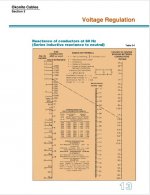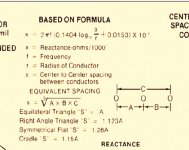wwhitney
Senior Member
- Location
- Berkeley, CA
- Occupation
- Retired
NEC Chapter 9 Table gives reactances for "3-Phase, 60 Hz . . . Three Single Conductors in Conduit." The notes say "capacitive reactance is ignored," so this is an inductive reactance. A few questions:
1) For PVC conduit, I take it this is the impedance attributable to the current in one of the 3 conductors inducing an opposing current in the other two conductors (in aggregate, for all pairs of conductors). How would these values change for a single phase 2-wire circuit, or the case of a 3P4W wye supply, or a 3P3W supply plus a wire type EGC, or 6 conductors for 2 parallel sets on a 3P3W supply?
2) For steel conduit we get a higher reactance than PVC. If we have a wire type EGC as a 4th conductor in the conduit, how will the 60 Hz reactance change if that steel conduit is bonded to the wire type EGC at 0 ends, 1 end, or 2 ends? [0 ends, of course, is usually an NEC violation.]
Thanks,
Wayne
1) For PVC conduit, I take it this is the impedance attributable to the current in one of the 3 conductors inducing an opposing current in the other two conductors (in aggregate, for all pairs of conductors). How would these values change for a single phase 2-wire circuit, or the case of a 3P4W wye supply, or a 3P3W supply plus a wire type EGC, or 6 conductors for 2 parallel sets on a 3P3W supply?
2) For steel conduit we get a higher reactance than PVC. If we have a wire type EGC as a 4th conductor in the conduit, how will the 60 Hz reactance change if that steel conduit is bonded to the wire type EGC at 0 ends, 1 end, or 2 ends? [0 ends, of course, is usually an NEC violation.]
Thanks,
Wayne



